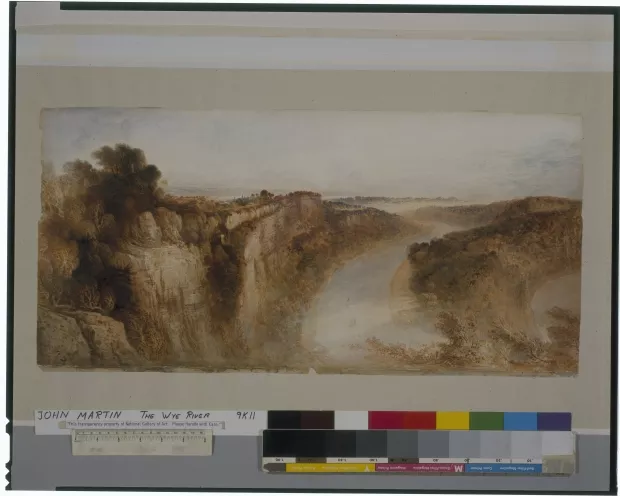Creation Date
1844
Height
31 cm
Width
64 cm
Medium
Genre
Description
Light brown cliffs, partially cloaked in dark green plant life, take up most of the left half of the painting. Near the center of the piece two small boats work their way along the river, which curves dramatically from the right border of the painting to the immediate foreground, then back to the horizon, where it meets a mostly-cloudy sky. The river wraps around a wooded peninsula, and the cliffs on the left also feature forest. The branches of a tree in the lower right of the painting help frame the river.
John Martin's View on the River Wye, Looking towards Chepstow was painted in 1844, near the end of the Romantic period. The painting focuses almost exclusively on the impact of the scenery on the viewer, rather than the compositional merits of the scene as a whole. As such, it represents the post-"Lines" (referring to Wordsworth's "Lines Composed a Few Miles Above Tintern Abbey") focus on the effects of nature on the individual, as opposed to the pre-"Lines" focus on critiquing nature's art.
Although Martin’s typical depictions of the sublime had fallen out of critical favor during the 1830s, View on The River Wye, Looking Towards Chepstow addresses the sublime in a different manner, and was executed in a period of renewed critical appreciation for his work: Martin exhibited at the Royal Academy every year from 1841 to his death, and this watercolor was exhibited in 1845 (Pendered 248). More focused than his earlier works on the effect that the sublime will work on the viewer, the piece uses sweeping brushstrokes to create a sense of movement that is remarkably different from Hearne’s or Gilpin’s static depictions of the picturesque. Although he includes several picturesque qualities—a contrast in textures between the plant life and the cliffs; chiaroscuro in the chalky bluffs and the dark horizon; and the swirling river against the static cliffs—Martin does not seem preoccupied with what makes this particular scene unique or superior to others. Rather, the lack of topographical detail and abundance of movement suggest a far more personal significance, a characteristic emphasis found in most Romantic responses to landscape. The personal nature of the piece is not surprising: it was created in 1844, well after the publication of Wordsworth’s “Lines Composed a Few Miles Above Tintern Abbey,” and near the end of the Romantic movement in literature. This subjective tone is a marked departure from the topographical recreations of Hearne and from Gilpin’s habit of rearranging scenery to create a properly "picturesque" scene, and Martin’s lack of precise detail makes clear his lack of interest regarding the particulars of the scene. Instead, in the fashion of the great Romantic poets, Martin is using Nature as a Muse—as a way to access personal truths. He does not treat the natural scene as an art work to be improved upon (in the style of Gilpin), nor as a geographical entity to be preserved for posterity (in the style of Hearne). This variation in thinking about the self and the world serves as a microcosm of the massive paradigm shift occuring during the Romantic period, and underscores the important differences between the early Romantic notion of the picturesque and the later Romantic formulation of Nature’s impact on the self.
Associated Works
Locations Description
Located approximately two miles above the junction of the rivers Wye and Severn, Chepstow was the final stop on the Wye Tour. Its most magnificent, picturesque view is undoubtedly Chepstow Castle, which served as the last great spectacle of the Wye Tour.
Copyright
Copyright, 2009, Romantic Circles.
Collection
Accession Number
1990.87.1
Additional Information
Bibliography
Andrews, Malcolm. In Search of the Picturesque. Stanford: Stanford UP, 1989. Print.
Feaver, William. “Martin, John (1789–1854).” Oxford Dictionary of National Biography. Ed. H. C. G. Matthew and Brian Harrison. Oxford: OUP, 2004. Online ed. Ed. Lawrence Goldman. Jan. 2008. Web. 31 Mar. 2009.
Gilpin, William. Observations on the River Wye. 1782. Oxford: Woodstock Books, 1991. Print. Revolution and Romanticism, 1789-1834.
Martin, John. View on the River Wye, Looking towards Chepstow. 1844. The National Gallery of Art, Washington, D.C. National Gallery of Art. Web. 26 Aug. 2013.
Pendered, Mary L. John Martin, Painter His Life And Times. Grand Rapids: Kessinger, 2005. Print.

